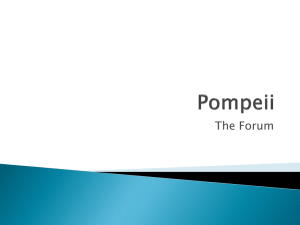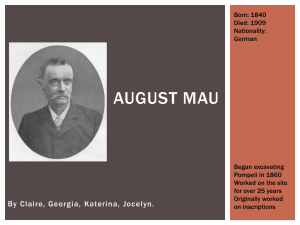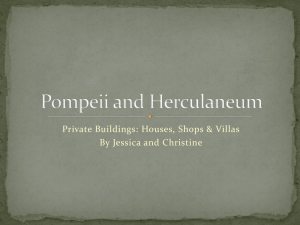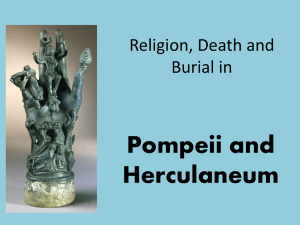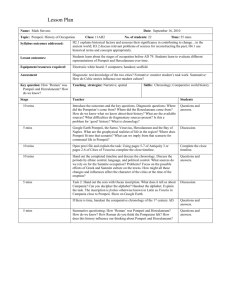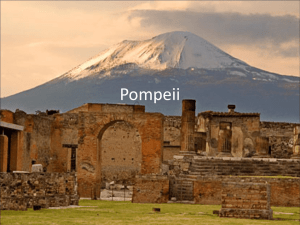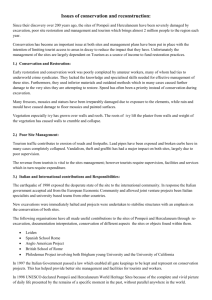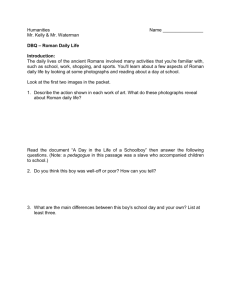Pompeii and Herculaneum
advertisement
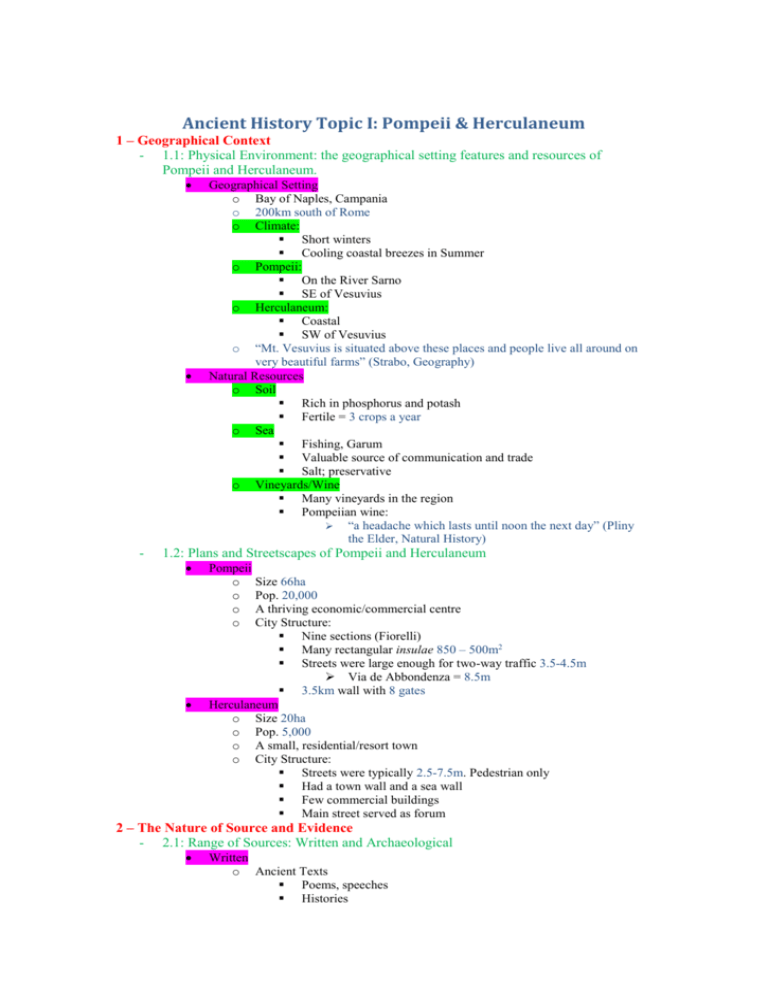
Ancient History Topic I: Pompeii & Herculaneum 1 – Geographical Context - 1.1: Physical Environment: the geographical setting features and resources of Pompeii and Herculaneum. - Geographical Setting o Bay of Naples, Campania o 200km south of Rome o Climate: Short winters Cooling coastal breezes in Summer o Pompeii: On the River Sarno SE of Vesuvius o Herculaneum: Coastal SW of Vesuvius o “Mt. Vesuvius is situated above these places and people live all around on very beautiful farms” (Strabo, Geography) Natural Resources o Soil Rich in phosphorus and potash Fertile = 3 crops a year o Sea Fishing, Garum Valuable source of communication and trade Salt; preservative o Vineyards/Wine Many vineyards in the region Pompeiian wine: “a headache which lasts until noon the next day” (Pliny the Elder, Natural History) 1.2: Plans and Streetscapes of Pompeii and Herculaneum Pompeii o Size 66ha o Pop. 20,000 o A thriving economic/commercial centre o City Structure: Nine sections (Fiorelli) Many rectangular insulae 850 – 500m2 Streets were large enough for two-way traffic 3.5-4.5m Via de Abbondenza = 8.5m 3.5km wall with 8 gates Herculaneum o Size 20ha o Pop. 5,000 o A small, residential/resort town o City Structure: Streets were typically 2.5-7.5m. Pedestrian only Had a town wall and a sea wall Few commercial buildings Main street served as forum 2 – The Nature of Source and Evidence - 2.1: Range of Sources: Written and Archaeological Written o Ancient Texts Poems, speeches Histories - 2.2: Limitations, Reliability and Evaluation of Sources - Geographies Strabo o Inscriptions/Graffiti Political, Commercial and Personal o Business Docuents o Papyrus scrolls: House of the Papyri o Labels on wine jars and garum jars Archaeological o Buildings Commercial: Shops, workshops, markets Residential: domus, villas o Monuments Statues: State to Eumachia Tombs: necropolis o Decorative features Wall paintings, mosaics: House of the Faun o Public Utilities Water pipes Fountains o Artefacts Relating to trade, commerce and manufacturing o Jewellery Rings, bracelets, necklaces: “Ring Lady” o Weapons and armor o Modifications to roads, paths and buildings o Remains: Animals: Fiorelli’s plaster casts Humans: Fiorelli’s plaster casts Plants Food Limitations o “it is premature to say we understand Pompeii. It is at once the most studied and least understood of sites” (Wallace-Hadrill) o Gaps in knowledge about: Women Lower classes o Some buildings destroyed by eruption o Fragility of evidence: House of the Papyri o Little written accounts of Pompeii/Herc. Lifestyle Reliability o Pliny the Younger’s account Written from memory Purpose: to glorify Pliny the Elder o Graffiti Intentions/purpose Bias o Commemorative Inscriptions May highlight only positive aspects 2.3.1: The Eruption Evidence o Letters by Pliny the Younger “Its appearance can be best described by comparing it to an umbrella pine” (Pliny the Younger) o Ancient literary sources Statius “will future generations believe, when crops and these now deserted places once more thrive again, that cities and peoples are buried below” (Statius, Silvae) Suetonius “an eruption at Mount Vesuvius in Campania” (Suetonius, Titus) Dio Cassius o Archaeological remains of the towns o Modern Vulcanology Haraldur Sigurdsson Info. From Sources o Eruption Stages First Stage: Plinain phase: ash + pumice 20km in air Ashfall for 17 hours 2.7m deep Most people fled from Pompeii Second Stage Six pyroclastic surges; 400°C First two hit Herc. 3rd + 4th hit Pompeii 5th + 6th bury the cities o Impact of Eruption Geography Pompeii buried; 4m ash Herc. Buried; 25m solid volc. material Sarnus River diverted Coastline extended by 500m + raised 25km Casualties 90% Pompeiians escaped Between 2000-500 at Pompeii 500 Corpses found at Pompeii 300 Skeletons in Herc. - 2.3.2: The Economy Trade: o Exports Garum Wine Olive Oil Pottery Pompeii Small market for specific goods o Imports Lamps from Nth Italy (Herculaneum had little Pottery from Gaul evidence of Trade) Oil from Spain Wine from Sicily & Crete Commerce o Evidence Agriculture: Villae Rusticae Grain Fruit Olives Grapes Vineyards; inside and outside of walls of Pompeii Farms with presses and vats for olive oil and wine production “as much as 10 per cent of the land [inside the walls]…was in agricultural use” (Beard, 2008) Fishing and Garum: Fish market in the macellum Frecoes/mosaics of fish P Jars found throughout the empire Fishing hooks/nets H - Woollen Textiles Fulleries + Workshops Dye Works in Region I /w vats, amphorae for dyes Painted shop signs Statues to Eumachia; Four felt-making workshops Pottery Pottery workshops Wall painting of potter using a kick wheel Pottery found in houses Metalwork Objects: fish hooks, nails, saws, dishes, jewellery Metalwork shops /w tools inside A shop with a forge Bread Making 30 Bakeries in Pompeii /w mills Bakery of Sextus Patuclus Felix /w donkeys (remains found nearby) Carbonised remains of bread Infrastructure Large roads + cart markings Forum Macellum Over 130 shops (tabernae) across Pompeii Thermopolias 20 cauponau Occupations o Agriculture: o Animal Husbandry: o Fishing: o Manufacturer: o Art: o Commerce: o Food + Drink: o Transport: o Construction: o Service Occupations: P P H farmer, grape picker herdsman, pig breeder fisherman potter Fresco painter Money lender, banker baker, tavern operator mule driver, wagoners carpenter, architect, stone mason bath attendant, barber, prostitute 2.3.3: Social Structure Familiar (household) o Basic social unit o Paterfamilias (father)= head of familias o Classes: Freeborn Freedmen Slaves o Classes were distinguished chiefly by clothing o Mobility between classes existed Freeborn o Men Local elite + ordinary citizens Wealthy, prominent figures had presence in P&H (P) Marcus Holonius Rufus + Lucius Caecilius Jucumdus (H) Villa of the Papyri owned by father-in-law of Julius Caesar o Women Could not vote or stand for office Played active roles in supporting candidates Could own property (P) Eumachia + Marina = prominent (H) Julia Felix owned a large property Freedmen o Men o Slaves o o o - Women Could marry, many found wealthy partners Many worked in industries and small businesses Est. ¼ pop. In 79AD Often worked as tutors, secretaries or agents (P) Inscription; mentions slaves working in public taxation Slaves were known to work as performers: gladiators, music, dance 2.3.4: Political Life - Significant part of population Many owned workshops or ran small businesses (P) Vetti Brothers: House of the Vetti Political Status o P + H had local governments o Subject to decree from Rome Political Activity o Intense around election times Political graffiti; “around 2,800 examples have been found on the outside walls of houses and public buildings” (Cooley, p.112) “elect Publius Furius duumvir, a good man” (Cooley p.114) “It was harder to get a seat in the Pompeian city council than it was in the Roman Senate” (Cicero) o Public Criticism of magistrates Political graffiti: badmouthing magistrates 2.3.5: Everyday Life: Leisure & Water Supply Theatres o Evidence Theatres at P&H; Odeon Theatrical motifs in home decorations Graffiti about visiting + local actors o Pompeian Theatre Seated 5000 Auditorium divided into three levels: Ima Cavea: closest; most important Middle section: for public Summa Cavea: highest; females o Odeon Had “the stamp of late Hellenistic architectural tradition” (Cantarella & Jacobelli, p.108) Used for serious performances; lectures, poetry recitals, concerts o Herc. Theatre 2,500 people Life-sized statues o Performances: Entry was free, a piece of bone or ivory indicated seating Actors were popular, albeit had low social statues Performances were organised for religious festivities - Sport o Evidence (P) Large Palaestra Amphitheatre o Evidence (P) Amphitheatre, seated 20,000 Graffiti; wall paintings, reliefs o The Amphitheatre Divided into sections: Back: women Middle: citizens Front: distinguished guests/authorities Activities/ Munerum (spectacles) Gambling & Prostitution Prostitution 40 lupinar; private and public Gambling Dice Astragals Food and Dining o Enjoyed by all classes; lower usually at taverns o Evidence: Frescoes of wealthy dining; House of Vetti Skeletal remains (diet) Cooking utensils + tableware (silver + glass) Brick ovens (public oven, thermopolia) Metal braziers Triculiniums o Cooking: Portable braziers At thermopolias and caupounes Baths o Evidence: (P) Four: stabian, forum, central, sarno (H) Two: suburban, forum Water + Sanitation: o Towns got their water from springs in the Apennine Mtns, via a branch of the Augustan aqueduct o Evidence: A castellum acquae Lead pipes found under footpaths 40 public water fountains Water cisterns in large houses in the impluvium Large terracotta sewage pipes + gutter system (P) stepping stones o Sanitation was excellent in both towns due to extensive sewage systems 2.3.6: Public Buildings The Palaestra o Exercise ground /w a pool The Basilica o Housed the law courts o Had rows of Greek-style columns Temples o (P) Jupiter Apollo Venus Dionysus Isis The Imperial Cult - 2.3.7: Private Buildings - Inc. the genius of Augustus in the forum, later known as the temple of Vespasian Temple of Fortuna o (H) had no large temples, save a small shrine of the Augustales Forum (P) o Porticoes linked a series of two storey buildings Religious Temple of Apollo Temple of Jupiter Temple of the Genius of Augustus Temple of Fortuna Augusta Sanctuary of the City Lares Economic Macellum Mansa Ponderaria Building of Eumachia Political Basilica Comitium Statues: 40 inc. prominent citizens (Eumachia) Suggestum Theatres o (P) Large Theatre: 5,000 ppl. o (P) Odeon: 1,000 ppl. o (H)Theatre: 2,500 ppl. o Acts: Greek + Roman comedies Music recitals Farces Pantomimes Domus o Often attached to shops o Entered via a fauces then a vestibulum o Often had a: Atrium Tablinium Lararium Culina Triculinium Cubiculum Cenacula Villas o Villa Otium Residential villa In the country (Villa of Papyri) or in the suburbs (Villa of Mysteries) Over 100 found over Sarno plain Country villas were large: Villa of Papyri = 33465m2 o Villa Rusticae Agricultural villa Few have been discovered: (Villa of Pisanella) 2.3.8: Influence of Greek & Egyptian culture; art, architecture & religion Greek Influence o Evidence Statues Columns: colonnade; Doric, Ionian, Corinthian Masks; used in theatre o Cultural Practices Baths - Theatre (Greek Tragedies) Palaestra o Religion Adaptation of Greek gods: Temple of Dionysus (Bacchus) Egyptian Influence o Evidence: Nile Mosaic Statue of Horus Falco (House of Gilded Cupids) Temple of Isis o Religion: Cult of Isis 2.3.9: Religion Public Religion o The Capitoline Triad The Triad: Jupiter (prot. state) Juno (prot. women) Minerva (craftsmen) Temple: Temple at northern end of Forum “the…temple demonstrated the supremacy of Rome’s most prestigious cult” (Small, p.186) o Hercules, Apollo & Venus Heracles Considered to be the founder of (H) Cult popular among sailors & traders Apollo Introduced C 6th BC Temple of Apollo: western side of Forum Venus Worshipped as goddess of nature Became patron goddess of Pompeii 80BC Temple of Venus looked out to sea Venus is a motif in graffito and household artworks o Imperial Cult Augustua Fortuna Temple of Vespasian; east of Forum The Edifice of Eumachia, a celebration of Augustus’ Julian clan o Public Ritual Sacrificium Strict method; animal must be counted in mola salsa, knife is coated, entrails are burned, animal is divided up for people acc. social status Done for specific gods, conducted under Flamens o Hellenistic Cults Cult of Isis Mostly women Strong due to trade link with Alexandria Quality wall paintings illustrate Egyptian landscapes Annual festivals: The Navigation of Isis: 5th March The Isia: 15th-16th Nov Cult of Bacchus/Dionysus “an escape from the worldly reality into mystic communion with the god” (Deiss, p.110) Villa of Mysteries: paintings of the rituals of the cult of Bacchus Private Worship o Household Spirits Lares; prot. household o o Pentates; prot. stores Genius; generating force Vesta; goddess of innermost things Spirits of family’s ancestors The Lararium Shrine for household deities/spirits Rituals done by paterfamilias Often meals were given as offerings Death and Burial Death was used as an occasion to enjoy life Evidence: Skeletons engraved on goblets at the Villa of Pisanella Graffito encouraging people to live their lives to the fullest (P) Necropolis + Tombs; revealed social class 3 – Investigating, Reconstructing and Preserving the Past - 3.1: Changing Methods and Contributions of Archaeologists “together, the buried cities of Vesuvius form the longest continuously excavated archaeological zone in the world” (Foss, 2007 p.29) Pre-1863 o First discoveries: C 16th o First published reports: 1748 o Intermittently administrated: 1748-1863 Objects put in Naples Museum 1780’s Giuseppe Fiorelli 1860-75 o “Fiorelli arguably…had the greatest impact” (Cooley, A. 2003) o Numbering system: Houses, Insulae, Nine sectins. o Named streets & Gates o Top-down excavation o Systematic, careful excavation o Plaster Casts for human remains August Mau o Created a new classification system for frescoes; four unique styles 1st : C2nd BC 2nd : C1st BC 3rd : C1st BC – Early C 1st AD 4th : 45AD -> Vittoria Spinazolla 1911-1914 o Contributions: Excavated most of Via’ dell Abbondenza Caefully restored facades of houses, shop and taverns Reconstructed upper storeys and balconies o Methods: Explicit use of photography Amadeo Maiuri 1924-1961 o Contributions: A number of insulae around the Via dell Abbondenza The amphitheatre The palaestra Villa of Mysteries Estate of Julia Felix Created great international attention o Methods: Used mechanical equipment Placed roofs on buildings to protect Quick excavation, little documentation Fausto Zevi 1977 o Contributions: Halting excavations, changing to a conservative approach 1800 photographs - 3.2: Changing Interpretations; impact of new tech + research - Pietro Giovanni Guzzo 1995 o “Pompeii’s death is not in one blow. It is slow, but sure” (Guzzo, 1995 in Bradley) o Contributions: Trebled annual funds to site to $9m Attracted international groups of experts to conduct investigations at the site Conducted extensive cleaning and consolidation efforts in order to make the site more tourist friendly Developments in the 2nd half of the C20th o Focus change: Documentation, Conservation, Protection Answering archaeological questions with existing discoveries o Documenting Existing Finds Photography Electronic Databasing NEAPOLIS Mapping: photogrammetry o Long-term investigation/documentation projects 1978-86; The Houses in Pompeii 1978- ;The Insula of Menander 1988-; The Pompeiian Forum o Future-Oriented Archaeology at Pompeii Anglo-American Project Pompeii Trust: Conservation Academic publication Presentation for Tourism New Technology o Computer analysing technology o X-Ray Analysis Lady of Oplontis 1994 o Use of Modern Laboratories o Ability to analyse smaller samples Charcoal Use of Specialists o Architects o Photographers o Botanists, Biologists, Zoologists o Mechanical Scientists o Seismologists, Vulcanologists, Geologists o Chemical +Physical Scientists o Geneticists, DNA Experts New Research = New Understandings o Estelle Lazer = human remains Median ages Height averages Signs of disease Diet analysis o Muscle/bone study Determining occupations/social class Ring Lady o Cross-referencing Comparison with victims at Mt. St. Helens 3.3: Issues of Conservation & Reconstruction Italian and International Contributions and Responsibilities o Significant Groups Leiden Spanish School Rome Anglo-American Project Phildemus Project Brigham Young University University of California o - Action Excavations halted following 1980 earthquake, focus shift to conservation Projects to stabilise structures 1997: Italian gov’t allows gate revenue to be kept for conservation 1998: UNESCO; P+H = WHS 2003: began to move original pottery/artefacts to museums Management plans and better training of guides Impact of Tourism o (P + H) 2m people each year o Erosion of roads o Vandalism/graffiti o Theft/Souveniring Early Conservation Work o “Pompeii has been the victim of the fallacious conception that the archaeologists role consists merely of excavations” (Francis, K) o Speed > Conservation o Ties with crime syndicates o Inferior equipment o Exposure to the elements o Vegetation has been allowed to grow on buildings 3.4: Ethical Issues Human Remains o It is agreed: Bones pre-AD1000 are of great antiquity Cultural descendants > Scientists Adequate storage facilities Casts > real remains, where possible o Questions Custody? A function of their age? Storage/Display? Ownership/International Trafficking o Policing the internet o Proving whether something is stolen or owned o Laws to stop such exports has conflicted with the interests of cultural authorities The Italian charter allows treasure hunters to keep their finds, so long as they declare it and pay 5% of est. value. “felons, narcotics dealers and other criminal elements” (Green, p.143) “a slap in the face to those in administration who work for the conservation of its heritage” (Hooper, 2004) Replicas/Reconstructions o Replicas represent one persons perspective “there was evidence the skeletons had been manipulated” (Brennan and Lazer) o Digital imaging can change features of an object; taking from original meaning

